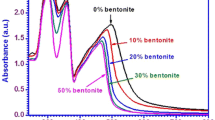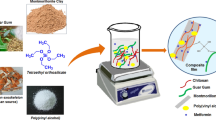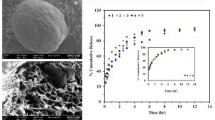Abstract
A semi-natural composite of κ-carrageenan and bentonite, two natural biopolymers, was synthesized through free radical polymerization. This synthesis aimed to obtain a biodegradable, biocompatible, and swellable composite that is environmentally friendly. The components used in this synthesis are readily available, making it economically feasible and promising for potential biomedical applications. The composite is pH-responsive and intended for oral delivery of metformin hydrochloride and aminophylline, which have low bioavailability and undesirable side effects, respectively. The organic composite exhibits the advantage of reducing drug release in the acidic gastric medium. This composite is a stimuli-responsive polymeric material that has garnered significant attention in recent years for its application in oral drug delivery systems. These materials enable site-specific and controlled drug release while minimizing toxicity. The carrageenan-g-poly(acrylamide-co-acrylic acid)/bentonite composite was characterized using Fourier transform infrared (FTIR) spectroscopy, X-ray diffraction (XRD), transmission electron microscopy (TEM), and field emission scanning electron microscopy (FE-SEM), which confirmed the successful synthesis of the composite. The swelling behaviour and point of zero charge of the composite were studied at different pH values, which showed a strong influence on the swelling properties of the composite. The drug loading capacity of the composite was measured at pH 5.3, and it was 70.60 mg/g for metformin and 95.66 mg/g for aminophylline at pH(3). The in vitro release profile of both drugs from the composite was also affected by the ionic strength, and it exhibited a lower release rate with higher salt concentration. The maximum release percentage of the drugs from carrageenan-g-poly(acrylic acid-acrylamide)/bentonite in simulated gastric, intestinal, and colon fluids was achieved within 40 h. The maximum release was 80% for metformin in simulated intestinal fluid (SIF) and 75% for aminophylline after 40 h.












Similar content being viewed by others
Data availability
This will be a future project and the phrase was created based on a request reviewer.
References
Bordbar-Khiabani A, Gasik M (2022) Smart hydrogels for advanced drug delivery systems. Int J Mol Sci 23(7):3665
Lin C-C, Lee C-Y (2020) Adsorption of ciprofloxacin in water using Fe3O4 nanoparticles formed at low temperature and high reactant concentrations in a rotating packed bed with co-precipitation. Mater Chem Phys 240:122049
Zain ZM et al (2023) A pH-sensitive surface of chitosan/sepiolite clay/algae biocomposite for the removal of malachite green and remazol brilliant blue R dyes: Optimization and adsorption mechanism study. J Polym Environ 31(2):501–518
Liu RH, Yu Q, Beebe DJ (2002) Fabrication and characterization of hydrogel-based microvalves. J Microelectromech Syst 11(1):45–53
Yang C, Suo Z (2018) Hydrogel ionotronics. Nat Rev Mater 3(6):125–142
Weng J, Tong HH, Chow SF (2020) In vitro release study of the polymeric drug nanoparticles: development and validation of a novel method. Pharmaceutics 12(8):732
Gupta R, Chen Y, **e H (2021) In vitro dissolution considerations associated with nano drug delivery systems. Wiley Interdisciplinary Rev 13(6):e1732
Alzayd AAM, Karam FF (2019) Adsorption of atenolol drug from aqueous solution by poly (AAM_MA) hydrogel and used in drug delivery system: study kinetic and thermodynamic. Res J Pharmacy Technol 12(10):4678–4682
Yan Y et al (2016) Enhanced transdermal delivery of sinomenine hydrochloride by ethosomes for anti-inflammatory treatment. J Drug Delivery Sci Technol 36:201–207
Malik S et al (2023) Natural polymer-based nanostructures and their applications. Smart Polymer Nanocomposites. Elsevier, pp 529–541
Pourmadadi M et al. Novel carboxymethyl cellulose based nanocomposite: A promising biomaterial for biomedical applications. Process Biochemistry, 2023
Gouthami K et al (2023) Introduction to polymeric nanomaterials. Smart polymer nanocomposites. Elsevier, pp 3–25
Karam FF, Alzayd AAM (2018) Swelling behavior of poly (aam_ma) hydrogel matrix and study effects ph and ionic strength, enforcement in controlled release system. Int J Appl Pharmaceut 318–325.
Zhang L, ** D, Stenzel MH (2021) Polymer-functionalized upconversion nanoparticles for light/imaging-guided drug delivery. Biomacromol 22(8):3168–3201
Abu-Dief AM et al (2022) Recent advances in mesoporous silica nanoparticles for targeted drug delivery applications. Curr Drug Deliv 19(4):436–450
Jacob PL et al (2023) Poly (diglycerol adipate) variants as enhanced nanocarrier replacements in drug delivery applications. J Colloid Interface Sci 641:1043–1057
Radhy ND, Jasim LS (2021) A novel economical friendly treatment approach: Composite hydrogels. Caspian J Environ Sci 19(5):841–852
Guo Z et al (2022) Carrageenan oligosaccharides: a comprehensive review of preparation, isolation, purification, structure, biological activities and applications. Algal Res 61:102593
Murugesan S, Scheibel T (2020) Copolymer/clay nanocomposites for biomedical applications. Adv Func Mater 30(17):1908101
Pacheco-Quito E-M, Ruiz-Caro R, Veiga M-D (2020) Carrageenan: drug delivery systems and other biomedical applications. Mar Drugs 18(11):583
Besli NSO, Orakdogen N (2021) Sepiolite-embedded binary nanocomposites of (alkyl) methacrylate-based responsive polymers: Role of silanol groups of fibrillar nanoclay on functional and thermomechanical properties. React Funct Polym 161:104844
Stealey ST, Gaharwar AK, Zustiak SP (2023) Laponite-based nanocomposite hydrogels for drug delivery applications. Pharmaceuticals 16(6):821
Kheirabadi M, Bagheri R, Kabiri K (2015) Structure, swelling and mechanical behavior of a cationic full-IPN hydrogel reinforced with modified nanoclay. Iran Polym J 24:379–388
Rafiee MH, Rasool BKA (2021) An overview of microparticulate drug delivery system and its extensivetherapeutic applications in diabetes. Adv Pharmaceut Bull 12(4):730–746
Kumar S et al (2017) Metformin-loaded alginate nanoparticles as an effective antidiabetic agent for controlled drug release. J Pharm Pharmacol 69(2):143–150
Bashir S et al (2018) Rheological behavior of biodegradable N-succinyl chitosan-g-poly (acrylic acid) hydrogels and their applications as drug carrier and in vitro theophylline release. Int J Biol Macromol 117:454–466
Gaware RU et al. (2019) Formulation and in-vitro evaluation of theophylline sustained release tablet. J Drug Delivery Therapeutics, 9(1-s): 48–51.
Aljeboree AM et al (2022) Synthesis of a new nanocomposite with the core TiO2/hydrogel: brilliant green dye adsorption, isotherms, kinetics, and DFT studies. J Ind Eng Chem 109:475–485
Malatji N et al (2021) Removal of methylene blue from wastewater using hydrogel nanocomposites: a review. Nanomater Nanotechnol 11:18479804211039424
Bulut Y, Karaer H (2015) Removal of methylene blue from aqueous solution by crosslinked chitosan-g-poly (acrylic acid)/bentonite composite. Chem Eng Commun 202(12):1635–1644
Dave PN et al (2023) Fabrication and characterization of a gum ghatti-cl-poly (N-isopropyl acrylamide-co-acrylic acid)/CoFe2O4 nanocomposite hydrogel for metformin hydrochloride drug removal from aqueous solution. Curr Res Green Sustain Chem 6:100349
El-Dessouky M et al (2018) Removal of Cs+ and Co2+ ions from aqueous solutions using poly (acrylamide-acrylic acid)/kaolin composite prepared by gamma radiation. Appl Clay Sci 151:73–80
Luan TB, Lam NT (2022) Deeply understanding delivery of Tetracycline under different morphologies of ZIF-8
Sharma S et al (2022) Adsorption of cationic dyes onto carrageenan and itaconic acid-based superabsorbent hydrogel: synthesis, characterization and isotherm analysis. J Hazard Mater 421:126729
Batirel S (2018) Theophylline-loaded pectin-based hydrogels. I. Effect of medium pH and preparation conditions on drug release profile
Al-Hussainawy MK et al (2023) Preparation of bentonite Clay/TiO2 nanocomposites surface as drug carrier: in-vitro release study of chloramphenicol drug. Int J Drug Delivery Technol 13(3):990–994
Sarioglu E et al. (2019) Theophylline‐loaded pectin‐based hydrogels. II. Effect of concentration of initial pectin solution, crosslinker type and cation concentration of external solution on drug release profile. J Appl Polymer Sci 9. 136(43): 48155.
Aljeboree AM et al (2023) Study on control-release and synchronized of metformin hydrochloride drug from hydrophilic polymers AgNP/SCC-g-poly (AAc-AAm). Int J Drug Delivery Technol 13(2):708–712
Katime I, Valderruten N, Quintana JR (2001) Controlled release of aminophylline from poly (N-isopropylacrylamide-co-itaconic acid) hydrogels. Polym Int 50(8):869–879
Ribeiro AC et al. (2011) Ternary diffusion coefficients of nickel chloride plus theophylline plus water at 298.15 K. Food Chem. 128(4): 957–960
Tipa C et al. Clay-Based Nanocomposite Hydrogels for Biomedical Applications: A Review. Nanomaterials 2022, 12, 3308. 2022, s Note: MDPI stays neutral with regard to jurisdictional claims in published
Osmałek T, Froelich A, Tasarek S (2014) Application of gellan gum in pharmacy and medicine. Int J Pharm 466(1–2):328–340
Nath J et al (2019) Development of a gelatin-g-poly (acrylic acid-co-acrylamide)–montmorillonite superabsorbent hydrogels for in vitro controlled release of vitamin B12. J Appl Polym Sci 136(22):47596
Taimoory SM et al (2018) The synthesis and characterization of a magnetite nanoparticle with potent antibacterial activity and low mammalian toxicity. J Mol Liq 265:96–104
Cetin M, Sahin S (2016) Microparticulate and nanoparticulate drug delivery systems for metformin hydrochloride. Drug Delivery 23(8):2796–2805
Güner OZ et al. (2018) Theophylline‐loaded pectin‐based hydrogels. I. effect of medium p H and preparation conditions on drug release profile. J Appl Polymer Sci 135(38): 46731.
da Trindade MT, Kogawa AC, Salgado HRN (2018) Metformin: a review of characteristics, properties, analytical methods and impact in the green chemistry. Crit Rev Anal Chem 48(1):66–72
Jabber EJ et al (2022) Synergistic effect of oxytetracycline as a combination treatment with Carboplatin on MCF-7 breast cancer cell line. Braz J Vet Res Anim Sci 59:e191527–e191527
Hu X et al (2015) Preparation and characterization of a novel pH-sensitive Salecan-g-poly (acrylic acid) hydrogel for controlled release of doxorubicin. J Mater Chem B 3(13):2685–2697
Wang Q, Zhang J, Wang A (2009) Preparation and characterization of a novel pH-sensitive chitosan-g-poly (acrylic acid)/attapulgite/sodium alginate composite hydrogel bead for controlled release of diclofenac sodium. Carbohyd Polym 78(4):731–737
Bashir S et al (2016) Synthesis, characterization, properties of N-succinyl chitosan-g-poly (methacrylic acid) hydrogels and in vitro release of theophylline. Polymer 92:36–49
Samanta HS, Ray SK (2014) Controlled release of tinidazole and theophylline from chitosan based composite hydrogels. Carbohyd Polym 106:109–120
Garg C, Saluja V (2013) Once-daily sustained-release matrix tablets of metformin hydrochloride based on an enteric polymer and chitosan. J Pharmaceut Educ Res 4(1):92
Ahmadi H et al (2023) Formulation of double nanoemulsions based on pH-sensitive poly acrylic acid/agarose/ZnO for quercetin controlled release. J Mol Liq 391:123363
Dave PN, Macwan PM, Kamaliya B (2023) Drug release and thermal properties of magnetic cobalt ferrite (CoFe2O4) nanocomposite hydrogels based on poly (acrylic acid-gN-isopropyl acrylamide) grafted onto gum ghatti. Int J Biol Macromol 224:358–369
Maggio AA et al (2022) Fe-and SiFe-pillared clays from a mineralogical waste as adsorbents of ciprofloxacin from water. Appl Clay Sci 220:106458
Lotfy VF, Basta AH (2020) Optimizing the chitosan-cellulose based drug delivery system for controlling the ciprofloxacin release versus organic/inorganic crosslinker, characterization and kinetic study. Int J Biol Macromol 165:1496–1506
Wali S et al. (2023) Synthesis, characterization and application of karak bentonite clay-graft-poly (Acrylamide/Co-Acrylic Acid) Superabsorbent Composite and its Adsorption Study for Selected Heavy Metals. J Chem Soc Pakistan. 45(3)
Aljeboree AM et al (2023) Enhanced removal of amoxicillin and chlorophenol as a model of wastewater pollutants using hydrogel nanocomposite: Optimization, thermodynamic, and isotherm studies. Caspian J Environ Sci 21(2):411–422
Acknowledgements
The authors are thankful to the Universities of Al-Qadisiyah, Iraq, and the College of Pharmacy, Kerbala University, for providing testing facilities.
Author information
Authors and Affiliations
Corresponding author
Ethics declarations
Conflict of interest
The authors report no conflicts of interest.
Additional information
Publisher's Note
Springer Nature remains neutral with regard to jurisdictional claims in published maps and institutional affiliations.
Rights and permissions
Springer Nature or its licensor (e.g. a society or other partner) holds exclusive rights to this article under a publishing agreement with the author(s) or other rightsholder(s); author self-archiving of the accepted manuscript version of this article is solely governed by the terms of such publishing agreement and applicable law.
About this article
Cite this article
Alzayd, A.A.M., Radia, N.D. Novel pH-sensitive of organic composite (kc-g-poly(AAc-co-AAm)/bentonite), synthesis and characterization candidate as a carrier for controlled release system in vitro to some drugs. Carbon Lett. 34, 505–517 (2024). https://doi.org/10.1007/s42823-023-00674-1
Received:
Revised:
Accepted:
Published:
Issue Date:
DOI: https://doi.org/10.1007/s42823-023-00674-1




